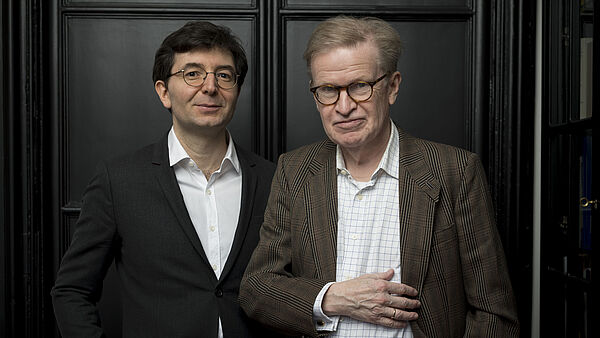
Eric Monnet, Dr.
Professor of Economics
École des hautes études en sciences sociales, Paris
Paris School of Economics
Born in 1983 in Angers, France
Studied Economics at the EHESS and Paris School of Economics
Project
Powering Capitalism. Revisiting the History of Central Banks (19th–21th Centuries)
Central banks are key economic and political institutions. They are at the heart of financial systems and money creation. Their actions have considerable consequences for macroeconomic and financial stability, inequality, and the financing of governments. My project is to write a history of central banks as an engine of capital accumulation and financial development. Three main actions of central banks have been crucial for this purpose: (i) anchoring and stabilizing expectations about the long-run value of money (price and exchange rate stability); (ii) ensuring liquidity in money and financial markets; and (iii) lending to certain agents (including non-financial institutions, such as firms or the state) to foster investment and capital accumulation, and sometimes discriminating between markets to influence the allocation of capital. These actions have taken different forms over time, depending on the financial system and its relationship with the state. Scholars have described at length the role of central banks in ensuring currency convertibility, the security of the payments system, and – later in the 20th century – the implementation of macroeconomic stabilization policies. The importance of central banks in the development of financial systems and the allocation of investments is less well known. We lack a general and comparative perspective on this kind of policies over the long run. The monetary and financial spheres are not independent. Managing money through interest rates, lending, or credit control confers financial power on certain public or private actors. This is where the history of central banking and the history of capitalism meet.Recommended Reading
Monnet, Eric. Controlling Credit: Central Banking and the Planned Economy in Postwar France, 1948–1973. Cambridge: Cambridge University Press, 2018.
Baubeau, Patrice, Eric Monnet, Angelo Riva, and Stefano Ungaro. “Flight‐to‐Safety and the Credit Crunch: A New History of the Banking Crises in France during the Great Depression.” The Economic History Review 74, no. 1 (2021): 223–250.
Monnet, Eric. La Banque-providence: Démocratiser les banques centrales et la monnaie. Éditions du Seuil, 2021. English: Banks of Providence: Central Banks and the Future of Democracies. Chicago: Chicago University Press, 2023.
Colloquium, 23.01.2024
How Central Banks Have Shaped Financial Systems Since the 18th Century. A Global Perspective
Over the past two or three centuries, central banks have become essential elements of modern states, on a par with the police, the judiciary, and the tax system. Unlike other attributes of the state, this development is relatively recent. It began in the early modern period but became the norm only in the mid-20th century. Before that, money was printed or controlled by governments without the need for a “bank.” There is no requirement that state money be printed by a bank. Similarly, key interest rates could be set by any independent or government agency. While the relationship between the government and the central bank has varied over time and still varies greatly from country to country, it is now an accepted fact that a state must grant special status to a single bank in order for it to become “central” in the financial system. Why is this so?
My argument is that central banks play a key role in shaping the financial system. Their raison d'être is a consequence of the state’s desire to promote financial development while retaining some control over the financial system. The ubiquity of central banks thus complements the rise of financial capitalism, and central banks are at the heart of the complex and changing relationship between finance and the state. Therefore, we can study the development of central banks as a product of the co-evolution of states and financial systems. As finance becomes more globalized, central banks also buy international assets, thus connecting the national financial system to international markets and trying to protect it from the vagaries of international finance. Since the creation of a central bank gives the state the power to finance economic activities off-budget, debates about the possibility of limiting this power are as old as central banking itself.
To support this main argument, I examine the history of central bank financial operations since the 18th century from a global perspective. Instead of focusing on money supply or interest rates, as quantitative historical studies of central banking typically do, I compare the types of loans central banks have made, the assets they have purchased, and the guarantees they have required from borrowers. In other words, the focus is on the role of central banks as special lenders – not only in times of crisis – because the choice of their financial operations can influence the types of financial assets that are traded in the economy and the way they are traded. The balance sheets and financial statements of central banks are therefore the main sources of my historical investigation. I depart from conventional narratives that trace the origins of central banks’ monetary policy or lender-of-last-resort functions. By contrast, I examine how central bank lending policies responded to the financial needs of the time and, in turn, structurally transformed financial systems.
Instead of defining central banks in terms of the functions they perform today, I consider all banks to which the state has given a special “central” status in the course of history, with the aim of facilitating access to credit and monetary instruments. This has two important implications. First, it breaks with the common Eurocentric history of central banking (based on institutions that still exist) and takes into account central banks that have ceased to exist and/or have been replaced by new ones. This includes colonial central banks (created by colonial powers) or central banks created in sovereign countries by foreign shareholders in an imperialist context (in Latin America and the Middle East at the end of the 19th century). Thus, the adoption of a global historical perspective aims to avoid teleological arguments and to highlight the different historical models of central banking. Second, it compares and distinguishes central banks from other financial institutions created by states to promote economic and financial development (e.g., the colonial chartered companies of the 18th century, the industrial and agricultural public banks of the developmental states of the 20th century, and today’s sovereign wealth funds). These institutions were clearly distinct from central banks, but often interacted closely with them.
Finally, I will briefly discuss how this new historical perspective can inform current debates about the role of central banks, particularly with regard to the ecological transition, public debt, and digital currencies.
Publications from the Fellows' Library
Monnet, Eric (Paris, 2024)
L'Europe : du marché à la puissance publique ? La vie des idées
Monnet, Eric (Chicago, 2024)
Balance of power : central banks and the fate of democracies Banque-providence
Monnet, Eric ([Paris], 2021)
La Banque-providence : démocratiser les banques centrales et la monnaie La République des idées
Monnet, Eric (Oxford [u.a.], 2020)
Monnet, Eric (Cambridge [u.a.], 2019)
Monnet, Eric (Cambridge, United Kingdom, 2019)
Controlling credit : central banking and the planned economy in postwar France, 1948-1973 Studies in macroeconomic history
Lectures & Keynotes 04/29/24

